
Astilbes: Nature's Answer to Drought-Resistant Landscaping!
Published: 23/07/2024 | Updated: 23/07/2024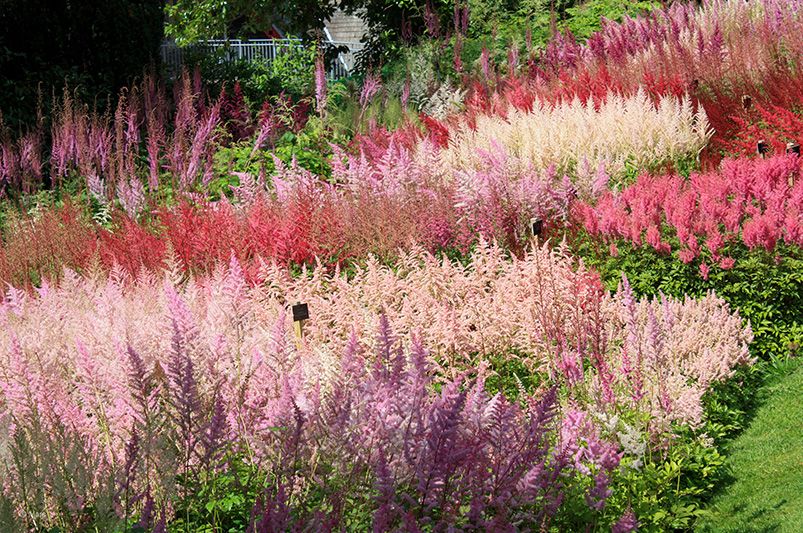
Astilbes are among the simplest perennial flowers to cultivate. Soft shades of white, pink, purple, and red adorn their long-blooming, plume-like flowers, carried aloft on stiff, tall stalks above an airy display of leaves. They may soften a sunny location or brighten up a shady garden, and they are pest-free and require minimal maintenance.


Astilbes can be planted in the spring or the autumn; however, it is best not to plant during the hottest summer months. If planting is necessary at that point, give the plant plenty of water until fresh growth appears. Although these plants grow slowly, once they are established, they will bloom for many years before needing to be divided.
Are you dreaming of a vibrant Astilbe display? Consult ShrubHub to select the perfect varieties for your garden's unique conditions.
Caring For Astilbes
Astilbes are prized for their excellent, long-lasting colour in borders with partial shade, with few tall, vibrant flowers. Astilbe’s delicate leaf type also offers a pleasing textural contrast to plants like Ligularia, Heuchera, and Hosta, which have big, broad leaves. It can also be cultivated in containers.
They should be planted in the shade and get plenty of water in dry climates.
Varieties can bloom anywhere from the middle of spring until the end of summer. Planting various varieties of asphodelium will allow the bloom to last nearly the entire season. The plumes remain quite attractive for several weeks after they stop flowering. They don’t need to be dead-headed because they won’t bloom again.
Light Astilbe plants can thrive in full sun or shade but prefer growing in partial shade. Although they can tolerate a lack of sun, they need some sunlight for optimal growth to reach their full potential. The foliage will burn in full sun in hot weather and dry soils, so placing them somewhere they can bask in soft afternoon sun is your best bet.
Soil
Astilbe plants like slightly acidic soil (pH of about 6.0), which is rich and moist.
Achieve plant perfection! Let ShrubHub advise you on the ideal pH levels and soil composition for thriving blooms.
Watering
Astilbe plants require more hydration in warmer climates, particularly when placed in direct sunlight. They do not fare well during long droughts, which can cause the leaves to turn brown and dry. If the conditions are too dry for a prolonged amount of time, the plants will eventually perish. If it doesn’t rain, water deeply once a week at the base; do not water from above. Don’t let the soil get too wet to avoid root rot.
Humidity and Temperature
Even in severe climates, Astilbe plants are resilient, and hardy enough to withstand winter conditions. To protect the roots, cover the stem with two inches of mulch following the first hard frost. Although they may grow in a somewhat humid atmosphere, they can accumulate powdery mildew in humid weather.
Applying Fertilizer
Because Astilbe plants require phosphorus to flower, pick a fertilizer with a 5-10-5 or 10-10-10 chemical composition. Two weeks before planting, rake in some fertilizer; alternatively, sprinkle some granules on the soil right after the astilbe has been planted. Fertilize the plant every spring when the earth is still damp after it has taken root. Fertilizer should be applied to the soil; do not get any on the leaves, especially if wet, as it will adhere to them.
How to Prune
Astilbe plants require very little upkeep. The flower heads on the plant will dry and keep their beauty for several months. You can trim the blooms anytime they stray, or leave them untrimmed for winter interest and trim them back in the spring.
Propagation
Astilbe plants should be divided every four to five years to maintain vitality. Astilbe plants can develop swiftly under the right circumstances, necessitating more frequent division. Although Astilbe seed is easy to come by, germination can be challenging. Starting with a plant or division is the simplest option. In its first year, even a little plant will fill out swiftly and thrive.
- Aim to dig up the root ball in early springtime using a spade and split it into several equal-sized pieces.
- Plant again at the same depth of soil. As soon as the pieces are planted, give them plenty of water.
- After transplanting, the plants will swiftly reestablish themselves if you give them plenty of water.
Typical Plant Diseases & Pests
Astilbes are a gardener’s best friend because they seldom have problems; few insects or diseases affect them. Groundhogs and rabbits may visit to nibble on the sensitive young foliage, but once the plants fill out, your furry guests usually leave them alone.
Types of Astilbe
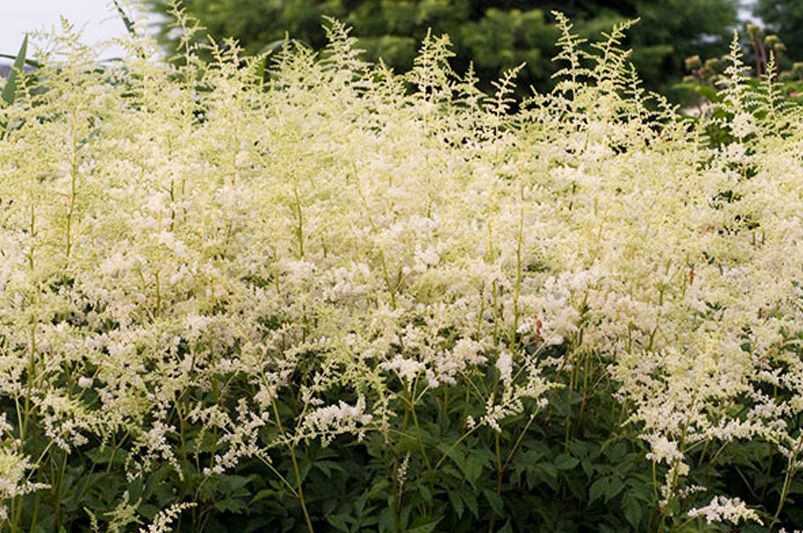
Bridal Veil Astilbe
Astilbe ‘Bridal Veil’ (Astilbe arendsii) is a compact, clump-forming perennial with ivory white blooms held in bright, pyramidal plumes that are striking in the night garden. It is dependable and accessible flowering. Each plume opens in succession to create a long-lasting floral show and is made up of hundreds of closely spaced small flowers that bloom in the early to mid-summer. Stems are robust and support them above a lovely mound of glossy, deep green leaves that resemble ferns. The flower plumes are long-lasting and develop a rich caramel colour that gives the garden winter appeal. This sturdy plant is resistant to deer and rabbits and is reasonably trouble-free, low care, and tolerant of severe shade. It also draws butterflies—the ideal perennial for a light-dappled, shaded border.
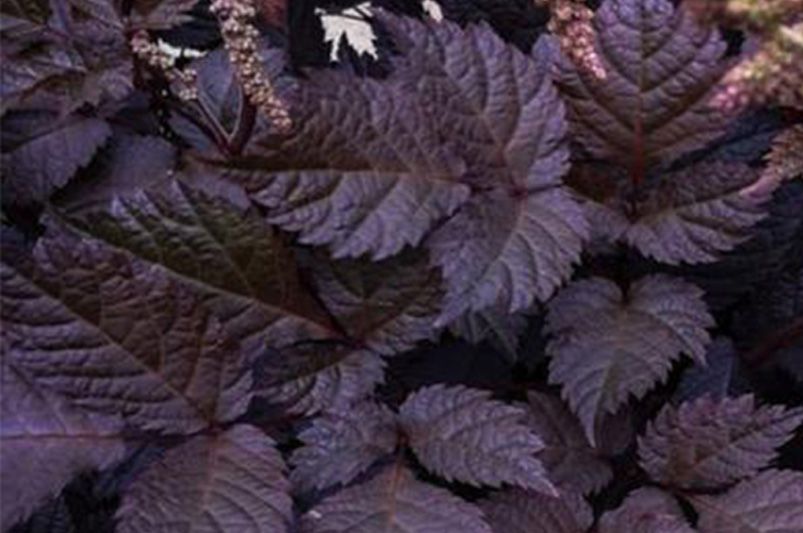
Chocolate Shogun Astilbe
Astilbe thunbergii ‘Chocolate Shogun’ is a dramatizing perennial that forms clumps and has glossy, bronze leaves that give the shady garden a long-lasting pop of color. In mid- to late-summer, the pink-tinged flower panicles create a dramatic contrast against the green. This gorgeous variety, which blooms when other plants are starting to fade, is low maintenance, fairly trouble-free, tolerant of severe shade, and attracts butterflies while also being resistant to deer and rabbits. The ideal perennial for a light-dappled, shaded border.
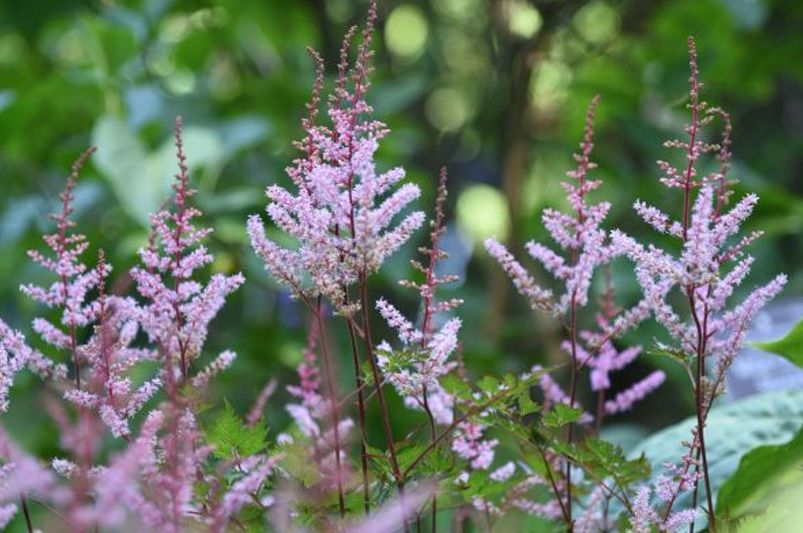
Delft Lace Astilbe
A real showstopper, Astilbe ‘Delft Lace’ displays long, pink-apricot flower plumes that stand upright and sturdy atop bright red stems. A showy shrub, they grow from deep pink buds and rise gracefully in early summer above a mound of fern-like, blue-tinted, speckled leaves with red highlights. A long-lasting plant, the petals turn a deep caramel color, which adds winter interest to any garden.
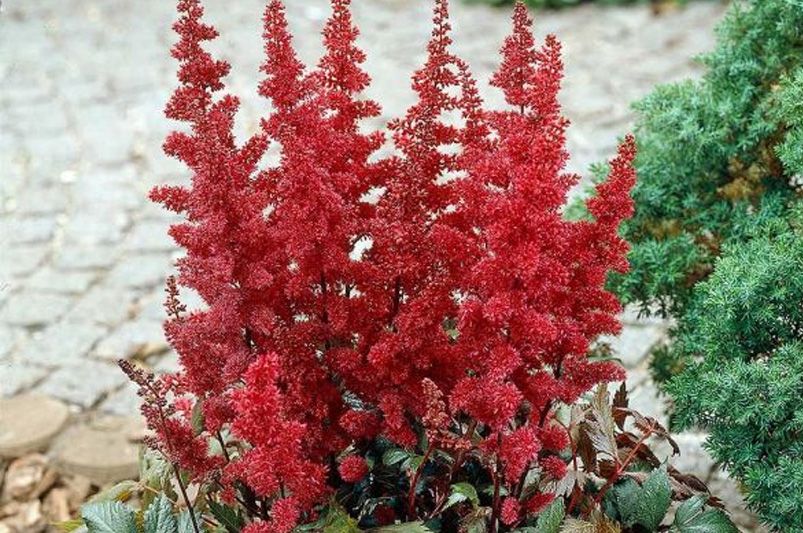
Fanal Astilbe
This award-worthy Astilbe ‘Fanal’ (Astilbe x arendsii) is a great option for any garden. Its long, slender, dark red plumes sit atop gorgeous bronze foliage from early to mid-summer, offering the darkest red flowers of all Astilbes. The small flowers that make up each plume produce a lengthy blooming season. The foliage acquires a deep green with a reddish undertone as the summer heat builds.
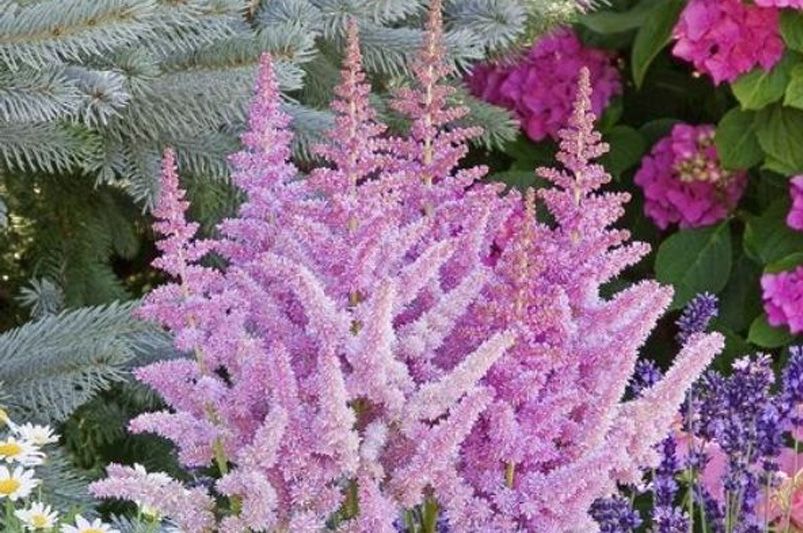
Little Vision in Purple Astilbe
Raspberry-purple flower spikes emerge straight from the plant’s center in the early summer. Savor these vibrant, long-lasting blooms for several weeks. Examine them closely to observe the succession of small real blooms opening. This perennial herbaceous plant fills in tiny areas with ease. Due to its modest stature, it’s an essential component of smaller urban gardens or a great “Thriller” when planted in pots on a covered deck or balcony.
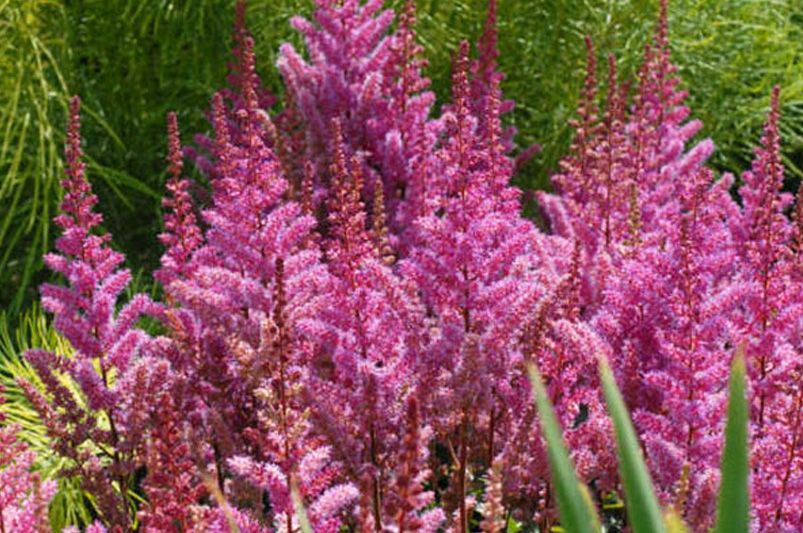
Maggie Daley Astilbe
Chinese Astilbe ‘Maggie Daley’ (Astilbe chinensis), a later-blooming cultivar, produces abundant and eye-catching bouquets of lavender-purple flower plumes held upright on sturdy stems. The hundreds of small flowers that make up each plume produce a lengthy blooming season. Quite spectacular, they rise elegantly from mid-to late summer over a lovely pile of glossy, deep green leaves that resemble ferns. Long-lasting, the flower plumes take on a deep caramel hue that gives the garden winter appeal.
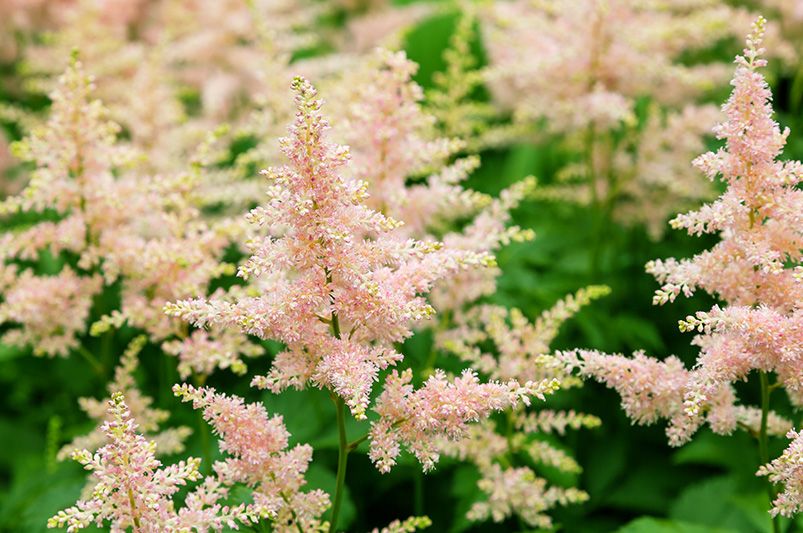
Peach Blossom Astilbe
Peach Blossom Astilbe (Astilbe x 'Peach Blossom') is a popular ornamental plant known for its stunning pink blooms. These blooms appear in early to mid-summer, adding fresh and colorful appeal to gardens and landscapes. This low-maintenance perennial can grow up to 24 inches tall and prefers partial shade and moist, well-drained soil conditions. Its lush foliage also makes it an excellent choice for adding texture and contrast to mixed border plantings.
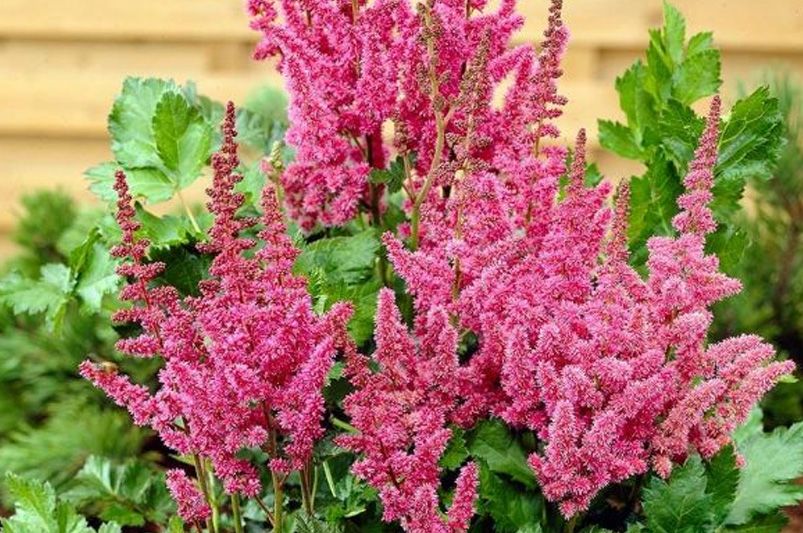
Visions Astilbe
Astilbe chinensis ‘Visions,’ also known as the Chinese Astilbe, is a compact, clump-forming perennial with dense, pyramid-shaped plumes that hold delightfully fragrant, raspberry-pink flowers. It is ideal for small gardens. Its plumes appear attractive as they arch over an eye-catching mound of enormous, fern-like, transparent green leaves; the blooms rise elegantly. When growing circumstances are favourable, the foliage maintains its beauty throughout the entire season. This dwarf shrub is tolerant of severe shade, blooms when other plants start to fade, is low maintenance and attracts butterflies despite being resistant to rabbits and deer. The ideal perennial for a light-dappled, shaded border.
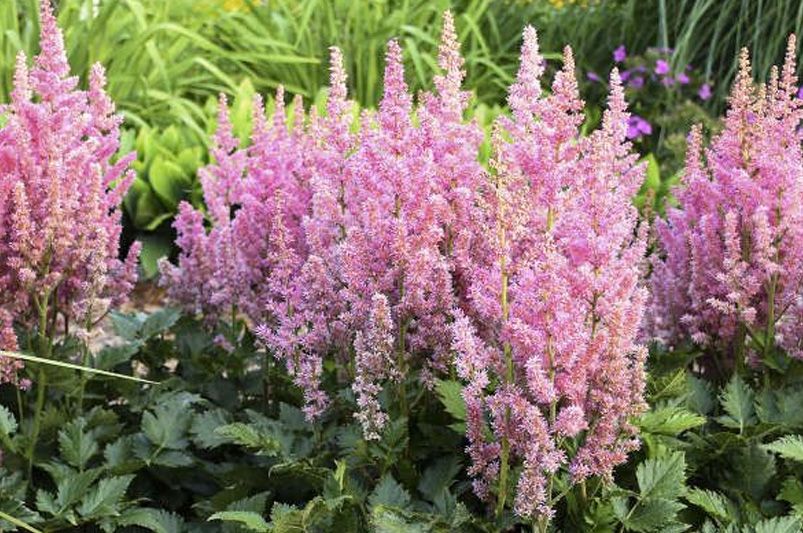
Visions in Pink Astilbe
A delightful addition to any outdoor space, each petal of these pink spectacles, which opens in succession to create a long-lasting floral show, is made up of a myriad of tiny flowers that bloom in the middle of summer. Held atop robust stems, the blooms rise gently above an eye-catching pile of blue-green, fern-like leaves. Under ideal growing conditions, the deeply cut foliage maintains its aesthetic appeal throughout the growing season. It flowers when other plants are starting to fade, and if it is pruned after the first flowering, it re-blooms beautifully in milder regions. It is reasonably trouble-free, resistant to rabbits and deer, and can withstand intense shade.
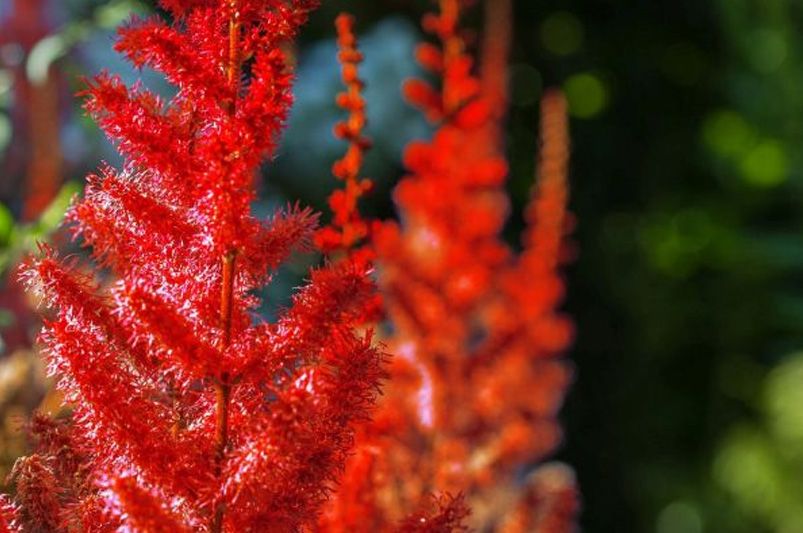
Vision in Red Astilbe
Instead of being a true red as the name would suggest, the flowers open up as incredibly vibrant purplish fuchsia. The flowers begin as deep red blossoms, and the leaves have outstanding bronze-green foliage with scarlet stalks. When not in flower, this plant makes outstanding foliage. Excellent for pond edges, borders, and shady gardens. It’s a great option if you live somewhere with a lot of seasonal variety, as it can handle a lack of sun as well as direct sunlight when mulched and well-watered. Astilbes look best when they are mass-planted, and Visions in Red is no exception. They are perfect for naturalising in a wild garden or bordering ponds. Although they can be displayed as cut flowers, it’s generally preferable to leave them in the yard so that you can enjoy their prominent, dramatic appearance for an extended period.
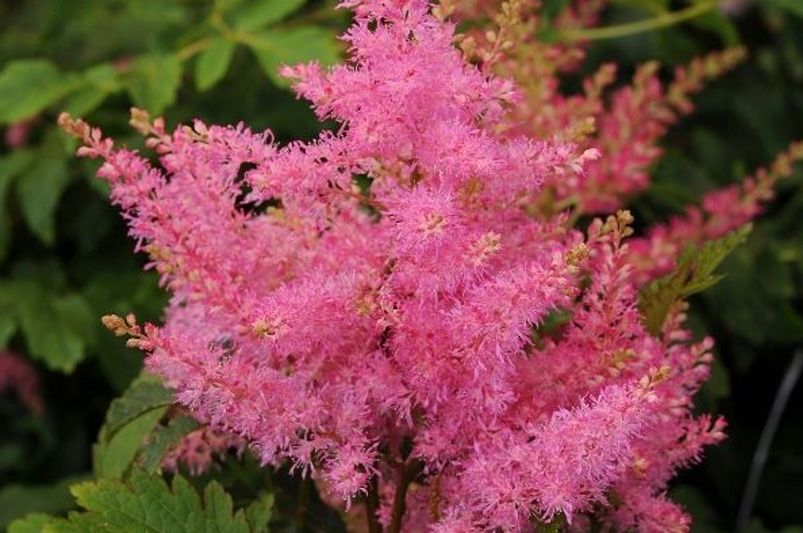
Younique Pink False Spirea Astilbe
This shrub’s pretty pink flowers rise over a lovely mound of glossy, deep green, fern-like leaves perched atop straight, robust stems. The flower plumes are long-lasting and develop a rich caramel color that gives the garden winter appeal. This pretty shrub is resistant to deer and rabbits but is quite trouble-free, low maintenance, and can withstand intense shade. It also draws butterflies—the ideal perennial for a light-dappled, shaded border. Younique Pink is a member of the ground-breaking Younique series of False Spirea, which is distinguished by its superior heat and drought tolerance, earlier bloom times, more flower plumes per plant, and enhanced resistance to disease.
Invite These Effortless Beauties into Your Yard
Astilbes are among the easiest perennial flowers to cultivate, featuring long-blooming, plume-like flowers in soft shades of white, pink, purple, and red. They add a delicate touch to both sunny and shady gardens and are low-maintenance, requiring minimal pest control. Best planted in spring or autumn, Astilbes thrive in partial shade with moist, slightly acidic soil. They need ample watering, especially in warmer climates, and benefit from phosphorus-rich fertilizer. Hardy and resilient, these plants offer visual interest even after their blooms fade, and they require minimal pruning and infrequent division to maintain their vitality. With varieties that bloom from mid-spring to late summer, Astilbes provide nearly season-long color, making them an excellent choice for borders, containers, and shaded garden areas.
Ready to add a touch of timeless beauty to your garden? While Astilbes are relatively easy to grow, consulting with a landscape expert can ensure they reach their full potential. Experts like those at ShrubHub can offer valuable advice on optimal planting locations, soil preparation, and watering strategies tailored to your garden conditions. Their professional insights can help you create a thriving garden that showcases the elegance of Astilbes, enhancing the overall aesthetic of your outdoor space. Working with landscape professionals allows you to enjoy a seamless gardening experience and the long-lasting beauty that Astilbes brings to any garden.


